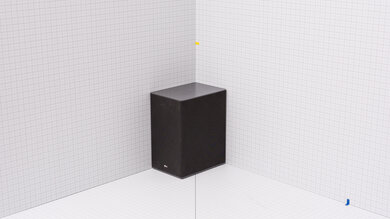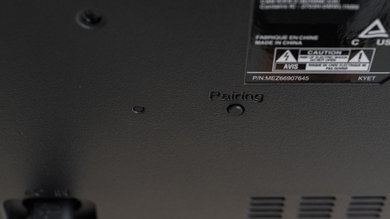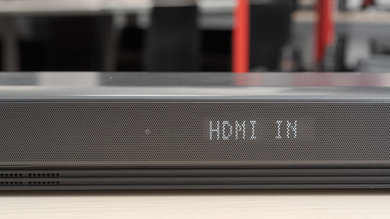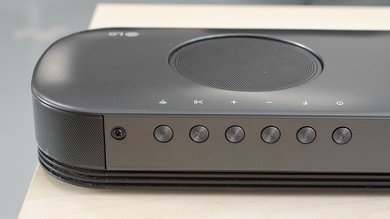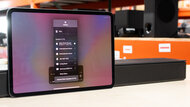The LG SK9Y is a decent 5.1.2 soundbar, but its sound profile might not be suited for everyone. It has disappointing bass performance, resulting in a bright sound overall. It also doesn’t get as loud as some other similar models as the bar seems to be limiting the volume output. On the upside, this also means it performs quite well at max volume. It also supports Atmos and has up-firing speakers for a more immersive listening experience.
Our Verdict
Decent for mixed usage. Unfortunately, the LG SK9Y has a bright sound profile with a noticeable lack of bass. On the upside, it still has a decent performance for voices and dialogue in movies, but gives a slightly boring sound for music and movies with lots of bass. It also supports Atmos for a more immersive experience with height channels. Unfortunately, its soundstage is fairly narrow and won’t feel as wide as the bar itself.
-
Well-built design.
-
Lots of connectivity options.
-
Disappointing and narrow soundstage.
-
Bright sound profile.
-
Lacks bass.
-
Doesn’t get very loud.
Good for dialog. The LG SK9Y can be used for audio content like audiobooks and podcasts thanks to the accurate reproduction of the mid-range frequencies. However, it doesn’t get very loud but should be loud enough for casual listening. On the upside, you can easily stream content wirelessly via Wi-Fi and Bluetooth. There’s also a dialogue enhancement feature, which will help make dialogue even clearer.
Decent for music. This soundbar has a bright sound profile that lacks bass that not everybody will like. Unfortunately, its soundstage is fairly narrow and doesn’t sound wide. On the upside, it can get loud for a casual listening session but won’t be ideal for large rooms or parties. At least it performs well at max volume and doesn’t compress. You can also EQ it slightly to your preference and stream content wirelessly from your smart device.
Decent for movies. It doesn’t have a very wide soundstage and surround objects feel diffused, but, on the upside, it supports Atmos for a more immersive experience. The sound profile of this bar lacks bass so it might not be ideal for action-packed movies as some may feel it's a bit boring. On the upside, it performs accurately at high volume, although its maximum volume output isn’t the highest, but it should be fine for most.
- 7.3 Mixed Usage
- 7.5 Dialogue/TV Shows
- 7.2 Music
- 7.2 Movies
Changelog
- Updated Jul 07, 2023: Confirmed in the Voice Assistant Support box that the bar supports Google Assistant through third-party devices.
- Updated Apr 06, 2021: Converted to Test Bench 1.0.
- Updated Sep 27, 2019: Review published.
Check Price
Popular Soundbars Comparisons
The LG SK9Y is a decent soundbar but has a fairly bright sound profile, which is disappointing considering its price point and the fact it has a dedicated wireless subwoofer. It also seems to be limited when it comes to loudness, as the SK9Y is noticeably quieter than most other high-end soundbars. See our recommendations for the best soundbars, the best Dolby Atmos soundbars, and the best soundbars with subwoofer.
The LG SK9Y is better than the Sonos Playbar, as we didn't test the Sonos with its sub and satellites. The 5.1.2 LG is more versatile as it has a decent performance with surround and Atmos content. However, the stereo soundstage of the Sonos is wider and more immersive. On the other hand, the Sonos doesn't have any HDMI ports. The LG also supports Wi-Fi wireless playback, is Bluetooth compatible, and has Chromecast built-in.
The LG SK9Y and Samsung HW-Q80R are both 5.1.2 setups, but the Samsung performs better in a variety of uses. The LG doesn't get very loud and it has a bright sound profile lacking bass. However, the Samsung has a more neutral sound profile that can produce deep thump and rumble. On the downside, the Samsung doesn't have as good surround sound performance.
The LG SK10Y is slightly better than the LG SK9Y from the same year. It's sleeker and better-built, and overall has better bass performance thanks to the sub. However, both bars seem to be limited when it comes to their volume output as they are noticeably quieter than other models.
The LG SN9YG is a better overall 5.1.2 soundbar than the LG SK9Y. The SN9YG feels better built, it's able to produce more bass, and it can louder. It has a slightly better center channel and surround performance, and there are also significantly more sound enhancement features. The SN9YG has eARC support as well as DTS:X support over its Full HDMI In port. However, the SK9Y has a significantly better height performance.
The Vizio SB36512-F6 is a better overall soundbar than the LG SK9Y since we haven’t tested the SK9Y with the optional satellites. The Vizio can get louder and has a great stereo frequency response. Its dedicated center channels also perform quite significantly better for dialog, but the Vizio lacks a dialog enhancement feature, which the LG does have. The LG soundbar is also better-built and should perform better with discrete surround speakers. It also has Wi-Fi compatibility and Chromecast built-in.
The Samsung HW-Q60R and the LG SK9Y have similar performance in mixed usage. The Samsung has a much better build quality, better center channel performance, and is more customizable; however, the LG has up-firing speakers to simulate height in Dolby Atmos content, has Chromecast built-in, and has more input selection.
Even though the LG SK9Y is a 5.1.2 setup and the Samsung HW-Q70R is a 3.1.2 setup, the Samsung is a better-mixed usage bar. It can get louder than the LG and has a noticeably better stereo performance, especially because of the great bass the sub provides. However, the LG has side-firing speakers and the Samsung can’t play surround content due to its configuration. The Atmos performance is also slightly better on the LG.
The Sony HT-Z9F and the LG SK9Y are both decently versatile soundbars, so you may prefer one over the other. They both consist of the bar itself and a dedicated wireless subwoofer with no satellites. The Sony feels more premium and better-built, and it can reproduce a more extended low-bass. On the other hand, the LG has better surround and Atmos performances. It also has more customization features, like bass and treble adjustments.
The standalone Sonos Arc is better than the LG SK9Y. The Sonos is better built and has better soundstage, center, and surround performances. However, the LG has a Full HDMI In port for high-quality passthrough.
The Samsung HW-Q800A is better than the LG SK9Y. The Samsung is a 3.1.2 setup with better soundstage and center channel performances. It reproduces a more extended low-bass, and it even comes with a graphic EQ. However, the 5.1.2 LG is better-built, and it has a better surround performance.
The LG SP9YA is better than the LG SK9Y. The SP9YA is better built with a better soundstage. It offers more sound enhancement features, such as room correction, and it also supports more wireless playback options. Some listeners may also prefer its more neutral, balanced sound profile out-of-the-box. That said, the SK9Y offers somewhat better surround and Atmos performances.
Test Results
The LG SK9Y setup doesn’t have satellites.
The soundbar has a good build quality overall. The subwoofer, made of metal and plastic, feels a bit better-built than the bar itself. However, it's covered by a fabric that can get dirty or damaged. The bar's overall feel isn’t very premium due to the mix of plastic and metal that don't blend well together in this case.
The LG SK9Y has a passable stereo frequency response. Its Low-Frequency Extension is slightly high, which results in the bar having trouble reproducing the deep rumble and thump of bass. The low-bass performance is quite sub-par overall as well. On the upside, the rest of the response follows our target curve quite well, but the lack of bass results in an overall bright sounding profile. For better bass performance, take a look at the Samsung HW-Q70R or the Sony HT-Z9F.
When listening to the LG SK9Y, the soundstage is decent. Although the bar is very large, the stereo speakers are positioned way in from the sides of the bar, which makes the soundstage narrower than the bar itself. On the upside, the sound is fairly focused, and objects come from an accurate pinpoint location rather than a general area.
Just like the SK10Y, the SK9Y doesn’t compress at its max volume, but unfortunately, it seems the bar is being limited when it comes to volume. This bar doesn’t get as loud as other similar models and won’t be a great option for a large room or crowded environments. For a bar that can get louder, take a look at the Vizio SB36512-F6.
The SK9Y's THD performance is okay. At a normal listening volume, the amount of THD is within decent limits. It's slightly elevated due to the spike in the mid-range, but overall won’t be too audible to most. However, at max volume, there’s a jump in THD, especially across the bass and mid ranges.
The SK9Y's center channel performance is good. Thanks to its 5.1.2 configuration, this soundbar has a dedicated center channel, which results in a clearer and more accurate audio reproduction of dialogue in movies. However, the bar doesn’t get very loud. The graph also shows a very bright sound profile due to the lack of bass, but there aren’t a lot of bass frequencies on center channels usually, so voices and dialogue should still be clear and accurate.
The LG SK9Y's surround performance is okay. The bar has side-firing speakers, which reflect sound off the walls to give you the impression of a wider surround sound. However, this also means this setup won't provide the most accurate and clear representation of surround objects in the soundstage, and it won't feel as real as discrete surround like with home theatre speakers. It also results in a muddy sound profile as the error compared to our neutral target curve is quite significant, both in the bass and treble ranges.
Just like the SK10Y, the SK9Y's sound is noticeably different with Atmos content. The bar has up-firing speakers that bounce the sounds off the ceiling, giving you the impression of height. However, the localization of objects is diffused and doesn't sound as real as the discrete localization provided by down-firing speakers. The bar sounds noticeably brighter than the performance with the center and surrounds channels.
The LG SK9Y has the same decent sound enhancement features as the SK10Y. It lacks room correction, meaning it might sound different depending on your room. On the upside, the adaptive sound control will help make voices clearer and it also has a night mode to normalize the level of different types of content. Also, you can adjust the amount of bass coming from the sub, and you also have the option to play with the rear level, although this setup doesn’t come with included rear speakers. However, you can purchase separate rears that are compatible with this setup.
The LG SK9Y has a nice set of inputs that can accommodate both newer and older devices. You can use the Optical port with older TVs and the Analog Audio In with any device that has an audio-out jack. The HDMI ARC and Full HDMI In ports are more versatile and offer support for higher quality sound formats than just surround sound, like Dolby Atmos. Finally, the bar also has an Ethernet port to connect to your home network.
Over HDMI ARC, the bar supports Dolby Digital and DTS for 5.1 surround sound on streaming platforms and Blu-rays. The SK9Y also supports Dolby Atmos and Dolby Digital Plus as a carrier for object-based surround sound. Unfortunately, you won’t be able to play lossless formats via ARC.
Via Full HDMI, the LG SK9Y supports pretty much every format, which is excellent. You can get 5.1 surround sound from Dolby Digital or DTS on content and video games that support it. You can also get object-based surround sound over Atmos and you can play lossless audio via 5.1 PCM or Dolby TrueHD with sources like a PC or a console.
Like most soundbars, the LG SK9Y supports both Dolby Digital and DTS via their optical cable. This means that it will playback 5.1 surround sound on almost any content that supports it like streaming platforms and Blu-ray discs. DTS isn't common on its own, but it's the fallback of the widely available, higher quality DTS-HD MA found on many Blu-ray discs.
The LG SK9Y has excellent wireless connections as it can connect using Bluetooth to your phone or tablet to play content. It can also connect to your Wi-Fi and use its Chromecast built-in. However, we were unable to make Chromecast work on YouTube, although it worked fine with Google Play Music.
The LG SK9Y can be connected between your TV and another source like a game console to play 4k @ 60Hz. However, it won’t do 4k @ 60 Hz @ 4:4:4 when connected to a PC so text will not look very crisp. On the upside, it does support HDR10, and can passthrough 4k @ 60 Hz at 10 bit, which can be useful for those who have a Blu-ray player or latest-gen gaming consoles.
The controls are at the back, although their corresponding icon is at the top. This feels slightly weird to use. There are buttons for changing inputs (using the 'F' button), play/pause, skip, changing the volume, switch to Wi-Fi, and powering the bar on/off. Just like with the remote, we weren’t able to use the play/pause and track skipping on ARC or HDMI In, but simply when the soundbar is playing via Bluetooth or when casting.
The remote is small and offers a good amount of control. You can change the volume, switch inputs (by pressing the F button), mute the soundbar or play/pause, and skip. However, just like controls on the bar, play/pause and skip didn't work with ARC or HDMI In, and they only seem to work when the soundbar is directly playing something via Bluetooth or casting.
The LG SK9Y doesn't have built-in voice assistants, but you can connect a third-party Google Assistant device to control it with your voice. That way, you can just ask your soundbar to get information on the weather or the traffic in your area.
LG Wi-Fi Speaker is a very simple app. It can't replace the remote as it lacks functions like the 'sound effects', but can do everything the on-bar controls can. You can play music from a media server on the network and create playlists, but nothing more than that.
The LG SK9Y automatically turns on when a recognized input is in use and turns off after being idle for a while. It will also shut down when disconnected from the source. You can use your TV’s remote for some basic control of the bar thanks to CEC support.
Comments
LG SK9Y: Main Discussion
Let us know why you want us to review the product here, or encourage others to vote for this product.
Update: Confirmed in the Voice Assistant Support box that the bar supports Google Assistant through third-party devices.





